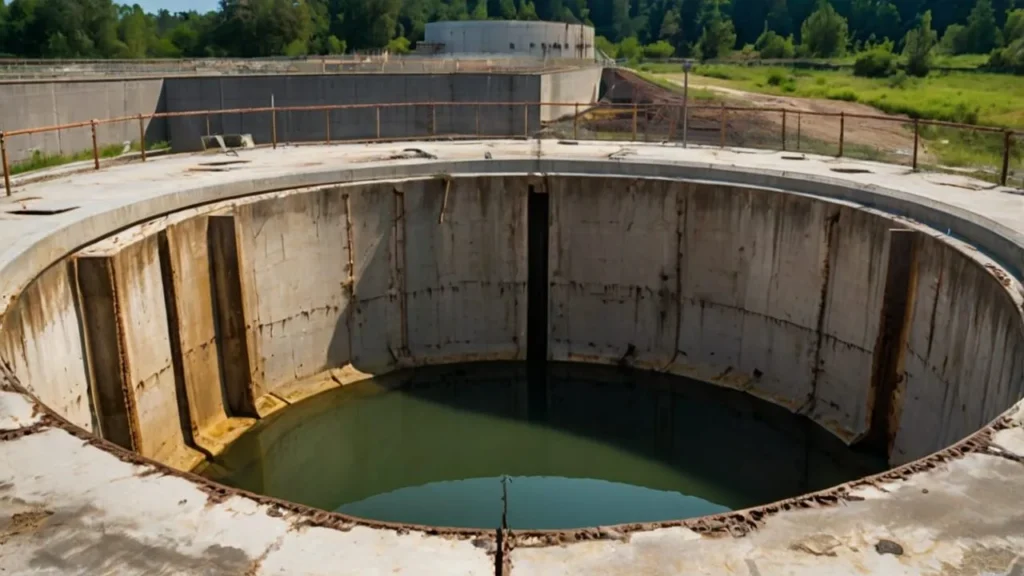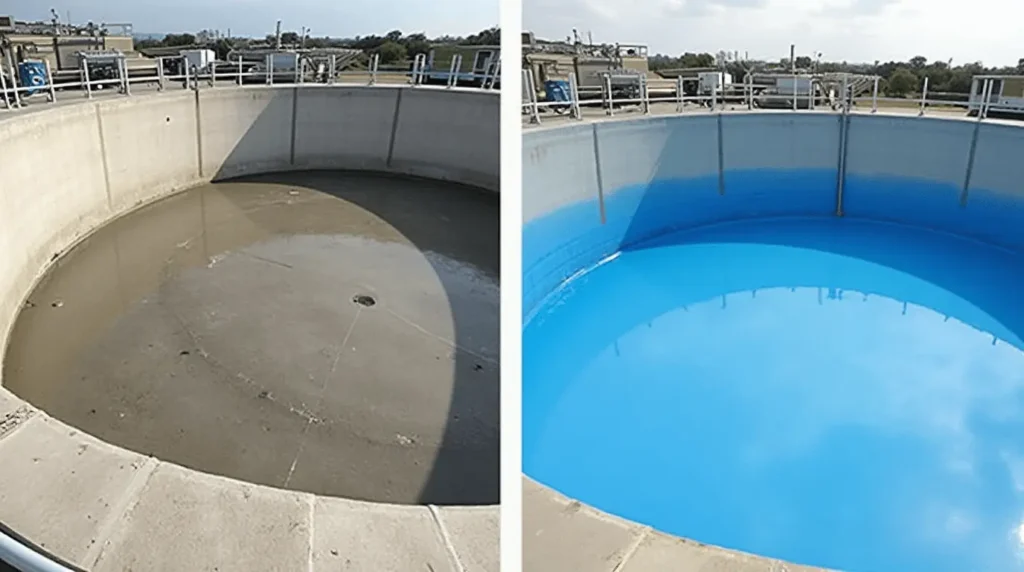📥Download more Real-World Polyurea Case Studies
Introduction
Wastewater treatment plants are the unsung heroes of modern sanitation. They work around the clock to protect public health and the environment. These facilities process millions of gallons of wastewater daily, facing challenges from chemical exposure, physical wear, and aging infrastructure.
In response, polyurea wastewater coating has emerged as a game-changer. It revolutionizes the way we protect and extend the lifespan of sewage treatment plants. This guide will explain how polyurea wastewater coating works and its benefits for infrastructure protection.
It will also cover the practical steps for successful implementation and long-term maintenance. Whether you manage a facility, make decisions for a municipality, or work in the industry, understanding polyurea wastewater coating is crucial. It ensures your operations run efficiently and sustainably.
Table of Contents
Understanding the Critical Role of Polyurea Wastewater Coating in Sewage Treatment Plants
Modern sewage treatment plants operate under intense pressure. They must treat vast volumes of wastewater while contending with aggressive chemicals, extreme pH variations, and constant moisture. Aging structures often struggle to keep up with increasing demands, leading to frequent repairs, costly downtime, and safety concerns. This is where polyurea wastewater coating steps in as a revolutionary solution.
Why Infrastructure Needs Advanced Coatings
Traditional repair methods—such as cementitious or epoxy coatings—often fall short when facing the rigorous demands of wastewater treatment environments. Conventional coatings can deteriorate quickly under the assault of aggressive chemicals like hydrogen sulfide or suffer from mechanical wear due to constant physical stress. As infrastructure degrades, facilities risk contamination, costly emergency repairs, and even complete system failure.
In contrast, polyurea wastewater coating offers:
- Superior Chemical Resistance: It can withstand exposure to harsh chemicals and corrosive agents.
- Exceptional Durability: Extends the lifespan of infrastructure by up to 400%.
- Rapid Curing: Sets in 6-30 seconds (touch-dry) and fully cures within 24 hours.
- High Flexibility: Adapts to structural movement with elongation capabilities of up to 400%.
- Versatility: Suitable for various surfaces and applications within a facility.
Table 1. Comparison: Traditional Coatings vs. Polyurea Wastewater Coating
| Feature | Traditional Coatings | Polyurea Wastewater Coating |
|---|---|---|
| Chemical Resistance | Moderate | Excellent – Withstands aggressive chemicals |
| Curing Time | Hours to days | 6-30 seconds (touch-dry), full cure in 24 hours |
| Durability | Lower longevity | Extends service life up to 400% |
| Flexibility | Limited | High elongation (up to 400%) |
| Application Versatility | Less adaptable | Ideal for a variety of surfaces and conditions |
This clear differentiation underscores why modern facilities are increasingly opting for polyurea wastewater coating to protect critical infrastructure.
Key Benefits of Polyurea Wastewater Coating
The benefits of polyurea wastewater coating are numerous and can be summarized as follows:
- Chemical Resistance: Protects against corrosive agents like hydrogen sulfide.
- Durability: Significantly prolongs the life of structural components.
- Rapid Application: Minimizes downtime with quick cure times.
- Flexibility: Maintains integrity even when the substrate moves.
- Versatility: Adaptable to various facility areas—from containment tanks to pipe galleries.
The Science Behind Polyurea Wastewater Coating

Understanding the technology behind polyurea wastewater coating helps clarify its advantages over traditional solutions. Polyurea is a synthetic resin created by the reaction of an isocyanate with amine-terminated resins. The resulting material forms a tough, elastic barrier that cures rapidly and adheres exceptionally well to a variety of surfaces.
Advanced Chemical Resistance and Durability
Polyurea wastewater coating stands out due to its superior resistance to the harsh chemicals present in wastewater environments. Facilities encounter acids produced by biological processes and industrial chemicals that can quickly degrade standard coatings. With polyurea wastewater coating, a robust protective barrier forms, preventing corrosion and ensuring long-term stability.
Additionally, its high tensile strength and flexibility allow the coating to resist:
- Mechanical stresses
- Temperature fluctuations
- Continuous moisture exposure
These properties ensure that polyurea wastewater coating remains intact, reducing the risk of cracks and leaks and thereby lowering the frequency and cost of repairs.
Rapid Curing and Application Efficiency
Downtime is a critical factor in wastewater treatment operations. Polyurea wastewater coating offers rapid curing times that greatly reduce service interruptions. With touch-dry times as fast as 6-30 seconds and full curing within 24 hours, facilities can quickly resume normal operations. This efficiency is particularly beneficial in large-scale installations where every minute counts.
Implementation and Maintenance Strategies for Polyurea Wastewater Coating
Deploying polyurea wastewater coating successfully requires careful planning, precise application, and consistent maintenance. Below are the steps and best practices for both the application and ongoing upkeep of this innovative coating system.
Steps for Successful Application
A systematic approach ensures the coating performs as intended:
- Surface Assessment:
- Conduct a thorough inspection to identify existing damage or wear.
- Surface Preparation:
- Remove old coatings, repair defects, and clean the surface meticulously.
- Pre-Treatment:
- Apply any necessary primers or pre-treatment agents as recommended by the manufacturer.
- Application:
- Utilize specialized equipment (e.g., hot-spray technology) to apply the polyurea wastewater coating evenly.
- Curing:
- Monitor the coating as it sets, ensuring that it cures within the specified time frames.
- Quality Control:
- Perform a final inspection to verify adhesion, uniformity, and overall quality.
- Documentation:
- Record all steps and findings to inform future maintenance and inspections.
Quick Reference: Application Process Checklist
- Surface Assessment
- Remove Old Coatings
- Clean and Pre-Treat
- Apply Coating with Hot-Spray
- Monitor Curing Times
- Conduct Final Inspection
- Document Process
Maintenance Protocols for Long-Term Success
Even after successful application, proactive maintenance is essential to maximize the lifespan and performance of polyurea wastewater coating.
Table 2. Maintenance Checklist for Polyurea Wastewater Coating
| Maintenance Task | Frequency | Purpose |
|---|---|---|
| Visual Inspection | Monthly | Early detection of wear or minor damage |
| Cleaning | Quarterly | Remove contaminants and debris |
| Touch-Up Repairs | As needed | Fix small areas before they become major issues |
| Comprehensive Inspection | Annually | Full review of coating integrity and performance |
| Documentation Update | Ongoing | Track maintenance and performance trends |
Regular inspections and preventive maintenance not only extend the protective properties of the coating but also help maintain compliance with safety and environmental standards.
Case Study: ISOMAT PUA 2230 – A Benchmark in Polyurea Wastewater Coating
Download NowOne of the leading products in the market, ISOMAT PUA 2230, exemplifies the cutting-edge technology behind polyurea wastewater coating. Its formulation and application methods have set new standards in the industry, making it a trusted solution for modern sewage treatment plants.

Features and Benefits of ISOMAT PUA 2230
ISOMAT PUA 2230 is engineered to deliver unmatched performance in harsh wastewater environments. Here’s a breakdown of its key features:
- Two-Component System:
- Combines a resin with an isocyanate for rapid chemical reaction and robust coating formation.
- Hot-Spray Application:
- Ensures even distribution and excellent adhesion for a continuous protective barrier.
- Enhanced Chemical Resistance:
- Specifically designed to withstand the corrosive agents found in wastewater.
- High Elongation and Flexibility:
- Can stretch up to 400% without compromising its structural integrity.
- Rapid Curing:
- Touch-dry in 6-30 seconds and achieves full cure within 24 hours, minimizing operational downtime.
Table 3. ISOMAT PUA 2230 – Key Specifications
| Specification | ISOMAT PUA 2230 Details |
|---|---|
| System Type | Two-Component (Resin + Isocyanate) |
| Application Method | Hot-Spray |
| Curing Time | 6-30 seconds (touch-dry), 24 hours (full cure) |
| Elongation | Up to 400% |
| Chemical Resistance | Superior – designed for harsh wastewater environments |
| Durability | Extends lifespan by up to 400% |
Long-Term Performance and Return on Investment
Investing in ISOMAT PUA 2230—and by extension, polyurea wastewater coating—offers significant long-term benefits:
- Extended Infrastructure Lifespan:
- Reduces the need for frequent replacements.
- Lower Maintenance Costs:
- Minimizes emergency repairs and prolongs service intervals.
- Operational Efficiency:
- Rapid application and curing reduce downtime and ensure continuous operations.
- Enhanced Safety and Compliance:
- Provides a reliable barrier against chemical and physical degradation.
The case of ISOMAT PUA 2230 clearly illustrates how polyurea wastewater coating transforms maintenance strategies, leading to both economic and environmental advantages.
Environmental and Economic Impact of Polyurea Wastewater Coating
The benefits of polyurea wastewater coating extend far beyond immediate operational improvements. This innovative solution plays a critical role in promoting environmental sustainability while delivering economic resilience.
Environmental Impact
Sewage treatment plants are vital in protecting water quality and preventing contamination. However, compromised infrastructure can lead to leaks and environmental hazards. Polyurea wastewater coating helps mitigate these risks by:
- Preventing Contamination:
- Forms a robust barrier that stops harmful chemicals from seeping into the environment.
- Reducing Repair-Related Waste:
- Extends infrastructure lifespan and minimizes resource consumption.
- Supporting Sustainability:
- Contributes to a greener, more sustainable approach to wastewater management.
Economic Benefits
While the initial cost of polyurea wastewater coating may be higher than traditional alternatives, the long-term savings are considerable:
- Lower Replacement Costs:
- Extended service life means fewer complete system overhauls.
- Reduced Emergency Repairs:
- Minimizes costly downtime and operational disruptions.
- Improved Efficiency:
- Rapid application reduces labor and downtime costs.
- Enhanced ROI:
- The cumulative savings on maintenance and repair expenses offer a robust return on investment.
Conclusion: Secure Your Facility’s Future with Polyurea Wastewater Coating
In an era where infrastructure reliability and environmental stewardship are paramount, polyurea wastewater coating stands out as an essential innovation for sewage treatment plants. Its unmatched chemical resistance, durability, and rapid curing capabilities make it an ideal choice for protecting the critical components of wastewater treatment facilities.
Key Takeaways
- Rapid Curing: Quick application means minimal downtime.
- Extended Durability: Up to 400% longer lifespan compared to traditional coatings.
- Superior Chemical Resistance: Shields against the aggressive agents common in wastewater environments.
- Economic Efficiency: Lower long-term costs and improved ROI.
- Versatile Application: Suitable for multiple surfaces and facility components.
By investing in products like ISOMAT PUA 2230, facility managers and municipal authorities can secure a future where wastewater treatment plants operate safely, efficiently, and sustainably. The combination of reduced maintenance costs, extended asset lifespan, and enhanced protection against harsh conditions makes polyurea wastewater coating a cornerstone of modern infrastructure management.
Take action now:
- Conduct a Comprehensive Facility Assessment: Identify key areas needing protection.
- Engage Certified Contractors: Ensure proper application of the coating.
- Implement Regular Maintenance Protocols: Use the provided checklist to maintain coating integrity.
- Monitor Performance: Document all inspections and repairs to inform future decisions.
With polyurea wastewater coating leading the way, your facility can meet today’s challenges and adapt to tomorrow’s demands, ensuring reliable, uninterrupted service for years to come.
For more detailed information on how polyurea wastewater coating can transform your facility’s protection strategy, contact industry experts and authorized distributors today. Secure your facility’s future with a solution that not only meets the rigorous demands of modern sewage treatment but also sets a new standard for durability and efficiency in environmental protection.

